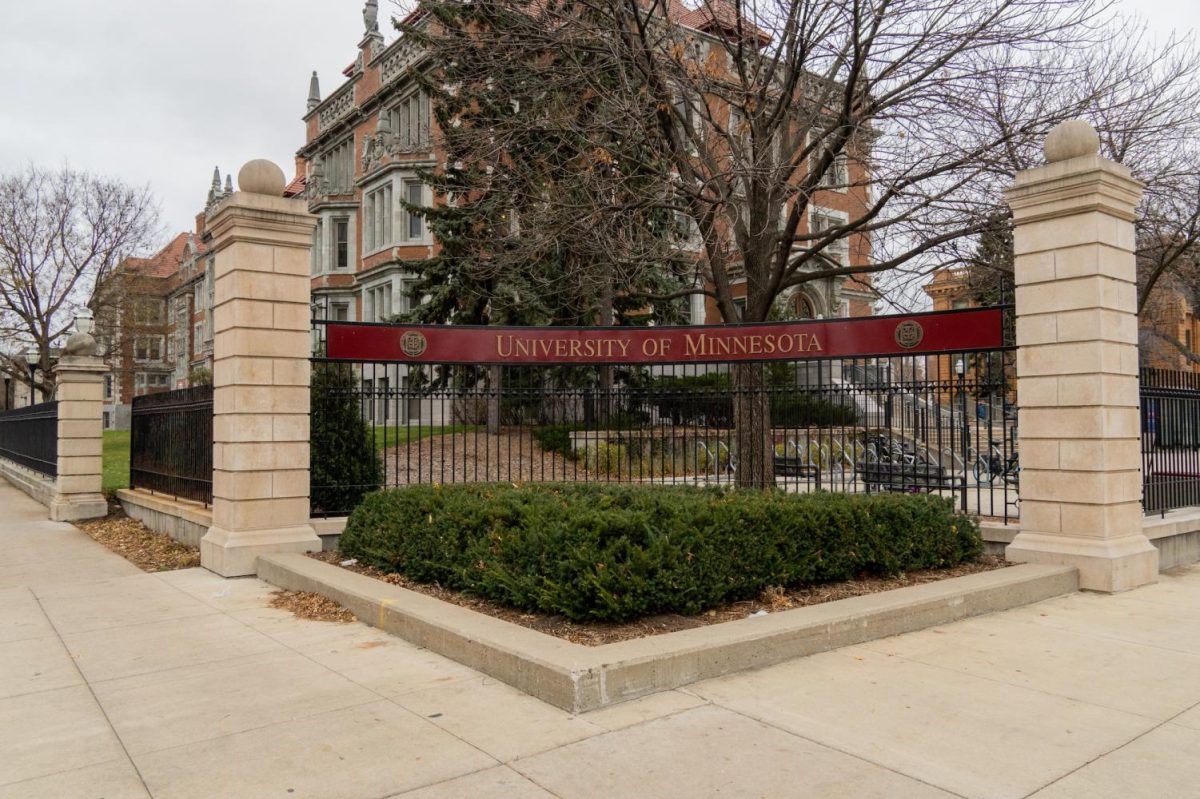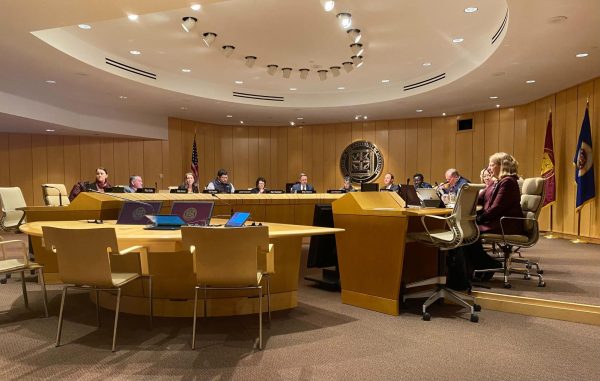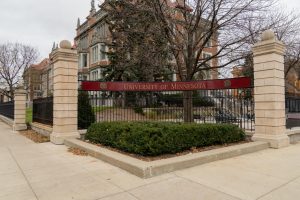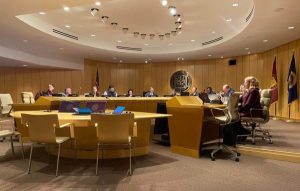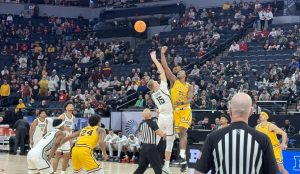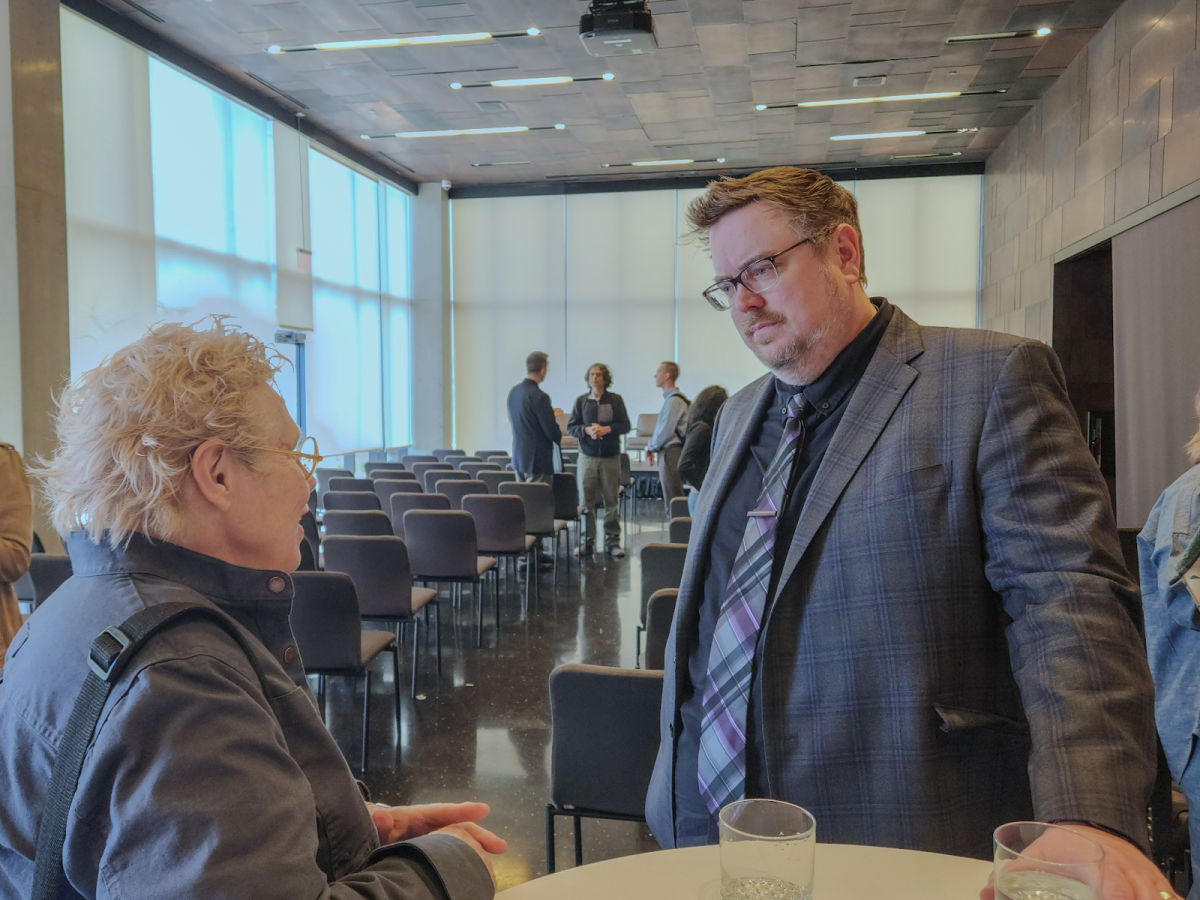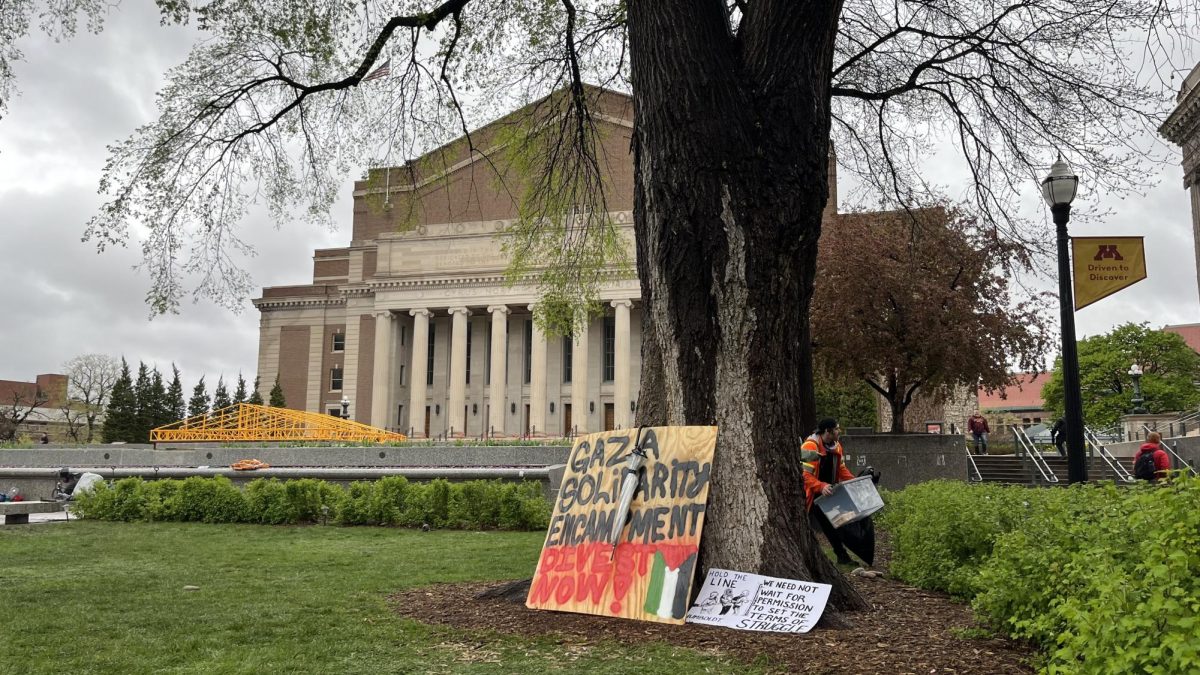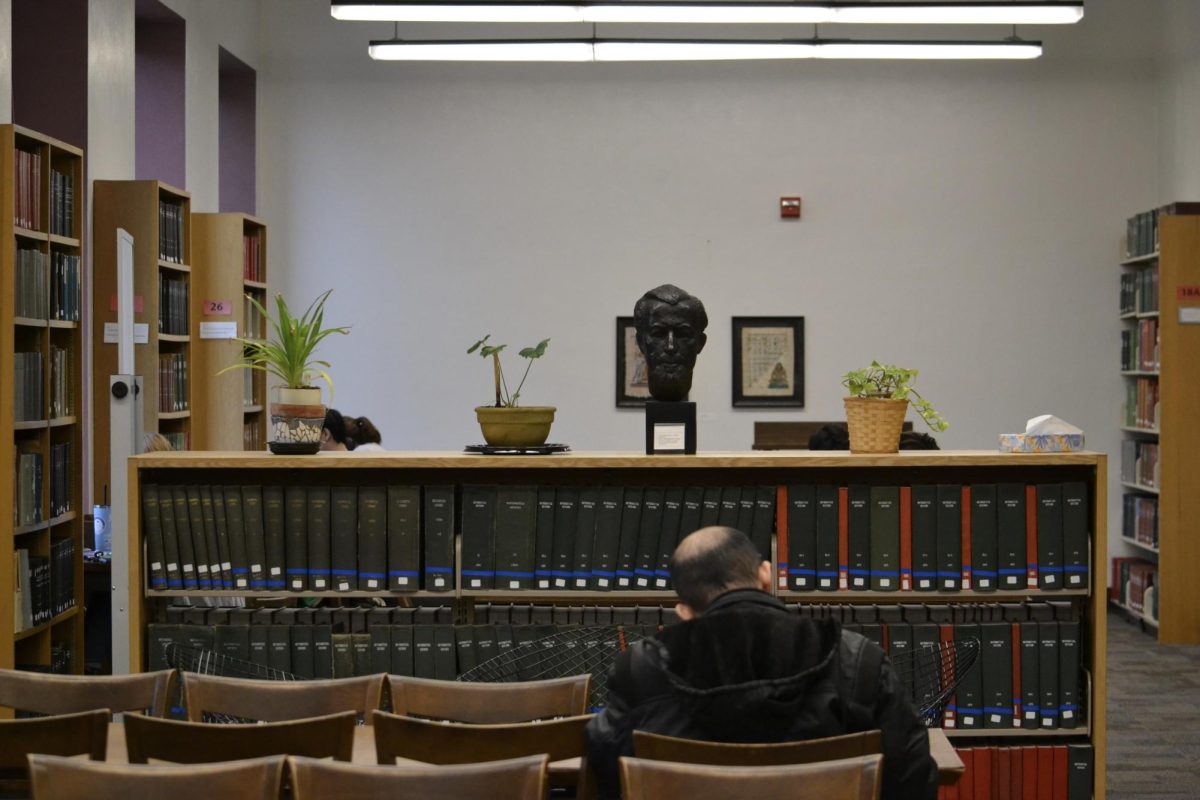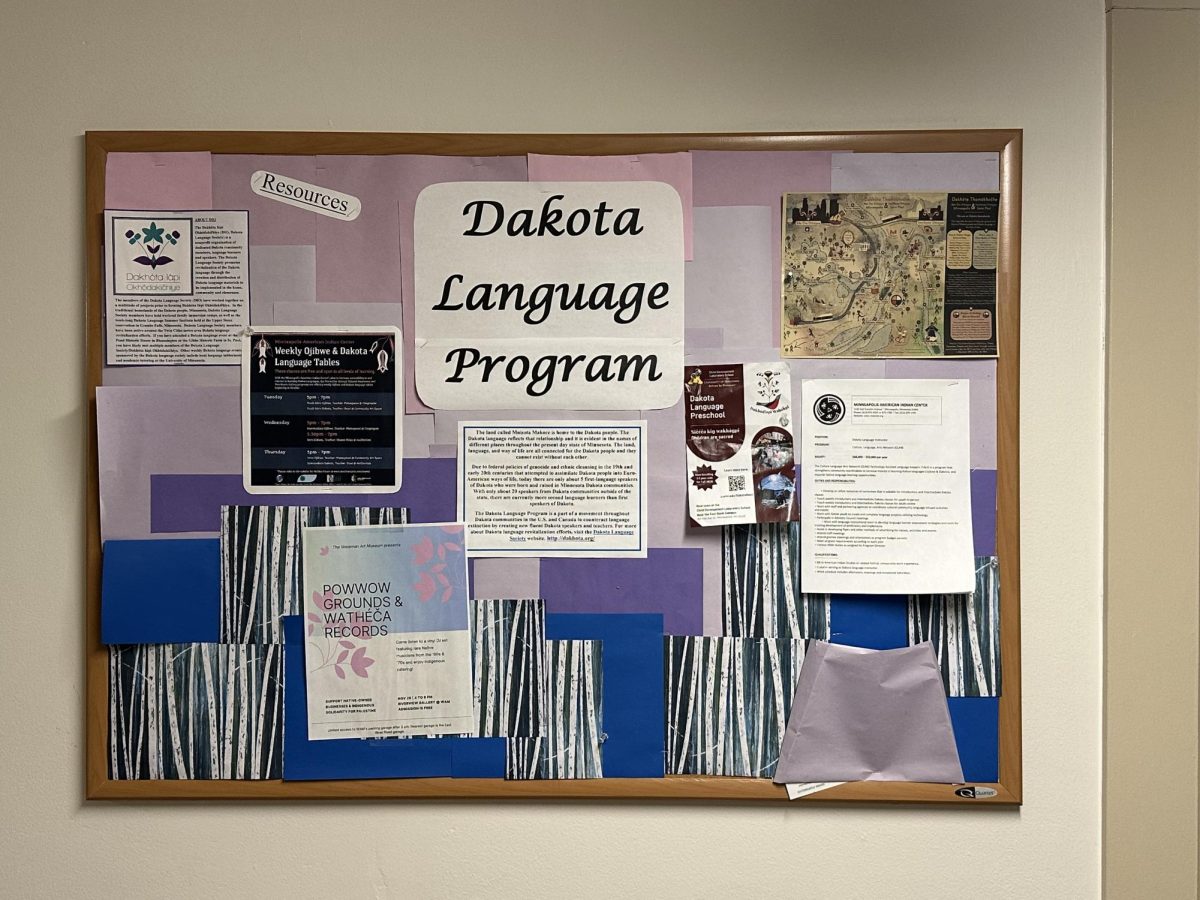Editor’s Note: The order of candidates is based on who presented the most recent.
The University of Minnesota held sessions for students, staff and faculty to meet each of the four finalists for the dean of the College of Liberal Arts since April 30 where each presented their vision for CLA’s future, bringing a search process that began with the announcement of a search committee last November to a close.
The University announced the creation of a search committee last November to fill the position of the previous CLA dean, John Coleman, who left to become the vice chancellor for academic affairs and provost at the University of Illinois – Urbana-Champaign last July. Ann Waltner has held the interim dean position since July 3, 2023.
The first three meetings were originally scheduled to occur in Coffman Memorial Union, but the venue was changed to the auditorium in the old Bell Museum on the East Bank following the University’s decision to close buildings around the Northrop Mall in response to the pro-Palestine encampment on Monday.
Jacob Pinholster
The fourth and last finalist, who met with students, staff and faculty in the McNamara Alumni Center’s University Hall on Thursday, is Jacob Pinholster, the current executive dean of enterprise design for the Herberger Institute for Design and the Arts at Arizona State University.
Pinholster began his presentation by acknowledging his lack of familiarity with the college and the University as a whole, which he said hinders his ability to speak with authority on the specifics of his vision.
“This is not really about presenting a vision that would be implementable,” Pinholster said. “It’s about a statement of values that I’ve prepared, that I can speak in public without choking on my own spit, and a demonstration of field-level awareness.”
Pinholster, who received both his B.A. and his master of fine arts from the University of Florida in 2000 and 2003 respectively, said his background in the fine arts and not having a Ph.D set him apart from the other three candidates. Pinholster also referenced ASU’s reputation for disruptive structural innovation.
“I’m a little bit of a dark horse candidate for this position,” Pinholster said. “I think for me to be useful to you in this process, I’ve decided to take a little bit of a different approach, which is go way out on a limb and present a radical vision of what the liberal arts could and maybe should be in higher education.”
Pinholster’s vision for the future of CLA focuses on the prefix “trans,” which he expands on as meaning the future of liberal arts and CLA is transformational, transdisciplinary, transcultural, trans-curricular, translational, transgressive and transcendent.
“The future is trans,” Pinholster said. “I love the prefix trans because in Latin it means this weird mix of both across and beyond, in an interesting way.”
On “transformational,” Pinholster said the future of the college should be focused on student transformation as an individual.
“The college experience is not just about how we go from knowing a little to knowing more,” Pinholster said. “It is about changing utterly who we are in that post-adolescent phase of learning to become an adult, acting as an independent agent in society, and how the education that we experience needs to match with that.”
On “transdisciplinary,” Pinholster said the college needs to create programs that include disciplines from different colleges.
As an example of what this could look like, Pinholster was one of three chairs on a steering committee at ASU that put together a B.S. in technological leadership, which teaches students problem-solving, technical design and leadership skills. The major includes coursework from nine different colleges.
“So it’s a place where everyone from someone who wants to open a florist shop to someone who wants to run a NASA mission can all work together to create different types of creative endeavors and to learn collaborative practices, creative practices, communication,” Pinholster said.
On “transcultural,” Pinholster said the college needs to bring together people from different cultures and create something separate from those cultures that brings everyone together and becomes a culture of its own.
“What is our educational pidgin, so to speak,” Pinholster said.
On “trans-curricular,” Pinholster said activities in the college need to be conducted across different curricula and involve the cooperation of those different curricula across the entire University.
On “translational,” Pinholster said the college needs to apply discoveries made in one field to other fields and teach students how to do that.
On “transgressive,” Pinholster said the liberal arts should defy our expectations of what education should be and use that to reshape how education is approached.
Finally, on “transcendent,” Pinholster said a liberal arts education needs to go beyond just meeting degree program requirements.
“It should reconnect us to the notion of why we’re all really here, which is that we want to understand the universe around us in really fundamental ways,” Pinholster said.
According to Pinholster, in practice this vision involves gamification of classes with challenge-based focuses to better engage students, develop assessment protocols for soft skills like communication and collaboration, eliminating course prerequisites in favor of demonstrated readiness, integrating curriculum with student affairs, utilizing emerging technologies such as artificial intelligence and virtual reality, and integrating the college with the surrounding Twin Cities community.
“I recognize that this is not necessarily implementable in any near future based on constraints both cultural and practical,” Pinholster said. “But this is, if I could wave the proverbial magic wand and turn liberal arts education in this country into something, this is what I would do.”
In his role as the executive dean of enterprise design for the Herberger Institute for Design and the Arts, which he has held since 2022, Pinholster oversees the executive director of Herberger Online Learning, which provides hybrid and online courses for students and oversees the development and strategic space planning for the institute’s facilities, which span 31 buildings and four cities.
Outside of being the executive dean of enterprise design, Pinholster is the founding director of ASU’s Media and Immersive eXperience Center, which opened in 2022 in partnership with the city of Mesa, Arizona, and serves as a venue for students to present their films, video games and other immersive media experiences. As the founding director, Pinholster oversaw facility design and planning and led the development of academic programs to use the facility.
Ann Waltner
The third finalist, who met with students, staff and faculty in the auditorium on Thursday, is Ann Walter, the CLA’s current interim dean and a history professor.
Speaking in the auditorium on Thursday, Waltner began by addressing the pro-Palestine encampment, which ended Thursday after the organizers came to an agreement with Interim President Jeff Ettinger.
“As a university and as a college, we need to figure out better ways of fostering conversations across political divides,” Waltner said. “I do not believe that every crisis is an opportunity, some crises are just crises. But I do think we need to look at the protests here and elsewhere and think about what they say about our mission as universities and as colleges.”
Waltner said her vision for CLA is to identify the college’s distinctive advantages, advantages that set the college and the University apart from others, and to build on them and invest in them.
“I would suggest that our chief distinctive advantage is that we are a public R1 university in a major metropolitan area,” Waltner said. “This does not make us unique, but it does make us distinctive.”
According to the Carnegie Classification of Institutions of Higher Education, an R1 ranking indicates a very high level of research activity for doctoral universities.
According to Waltner, elements of the University’s location that make it distinctive include the transformative effect on immigrant communities, such as Somali, Hmong and Latinx communities, as well as the presence of Indigenous and Black people, and the troubled history of these groups have had on the Twin Cities. According to Waltner, these elements make Minnesota the ideal place to begin thinking about changing American culture.
“We need to continue and intensify our diversity work as faculty and staff for a number of reasons, but the most compelling may well be that we live and teach in diverse communities, and we need to learn how to do it better,” Waltner said.
Waltner said the University and college have institutions that work with local communities, such as the Liberal Arts Engagement Hub and the Office of Public Engagement, something that they are expanding every year.
“We need to think about engagement not as an add-on, but as something that we do that is central to our mission as a college,” Waltner said.
Waltner said the first thing she would do if she became dean would be to start a strategic planning process in tandem with the University’s strategic planning process. Waltner’s plan would involve CLA’s governmental bodies, such as the council of chairs, and ad-hoc brainstorming groups, which she would pose a series of questions to, starting with what each group sees as the distinctive advantages of the University.
“I would welcome other answers, other ideas, even some pushback,” Waltner said. “I’d like to think that one of my strengths as a leader is that I welcome brainstorming, and I have, on occasion, been known to change my mind.”
The second question Waltner plans to ask is where they want CLA to be in 10 years and what do they need to get there. According to Waltner, the first thing the college needs to thrive is fiscal stability.
Waltner said roughly 80% of the college’s revenue comes from tuition and the college has seen budget shortfalls because of declining enrollment. Because of this, Waltner said the college needs to work on attracting more students and tackle the growing negative sentiment for higher education and liberal arts.
“Money matters,” Waltner said. “As the old song by Guy Clark says, there are only two things that money can’t buy, and that’s true love and homegrown tomatoes.”
Finally, Waltner said the college needs to fairly compensate and respect instructors who aren’t tenure-line faculty. According to Waltner, a substantial part of the college’s curriculum is delivered by these instructors.
“Some have multiple year contracts, but they don’t all have multiple year contracts,” Waltner said. “We can do better by them.”
Walter, who received her Ph.D. in history from the University of California, Berkeley, in 1981, has worked at the University as faculty since 1987. Before becoming the interim dean last July, Waltner served as the chair of the department of history.
From 2005 to 2014, Waltner also served as the founding director of the University’s Institute for Advanced Study, a University-wide center that provides funding support and other resources for students, staff, faculty and community partners in a wide range of practices and research.
GerShun Avilez
The second finalist, who met with students, staff and faculty Wednesday in the auditorium, is GerShun Avilez, an English professor and the associate dean for academic affairs at the University of Maryland – College Park (UMD), a public land-grant research university.
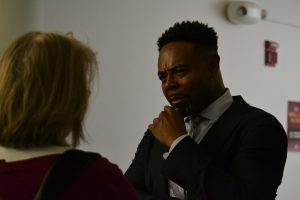
During his presentation, Avilez outlined his vision for CLA, which is to transform the college into “a pathway to and for the public.” Alivez said this means establishing and strengthening direct connections between each unit of the college and its surrounding communities as well as turning the college into a resource for community organizations and cultural institutions.
Alivez said the college can strengthen these communities by supplying well-qualified candidates to work there and by supporting social, cultural and political work.
“In other words, the college specifically can be a resource to the public,” Alivez said. “And I want to think about how we can do that in every decision we make.”
Alivez said the central question guiding his vision for CLA is how the college can ensure that it’s work touches and benefits as many people in Minnesota as possible.
“This is important to me because we don’t always think about the college or all of our units as having a function on campus,” Alivez said. “Maybe people turn to other colleges first, but I think we could turn to the College of Liberal Arts first to do that work. That’s the challenge I want us to think about.”
According to Alivez, this work has three foundational points for his vision: embedding the college in local communities, ensuring access for as many people as possible, and ensuring that staff within the college have successful and long careers.
As an example of what embedding the college in local communities might look like, Alivez said the college could continue to work with organizations like Literacy Minnesota to connect students with outside communities. As an example, Alivez said students could be placed in local libraries where people go to access the internet to help communities increase their digital literacy.
“This is just one example where we’re trying to think about how an initiative on campus can serve as a bridge or a connector for the public good,” Alivez said.
On Alivez’s second point, ensuring access, he said something the college could do is work with highschools that don’t have the resources to prepare students for higher education and build off of the University’s existing summer programs like Rooted in STEM to increase outreach.
“It’s incumbent upon us to think about how to keep our student population inclusive and that we ensure that students throughout the state have access to higher education,” Alivez said.
The third point for Alivez’s vision for CLA is ensuring that staff with the college have successful and long careers. According to Alivez, a good strategic plan not only has to consider how staff get into it but also how they benefit from it.
“Oftentimes when we’re talking about the university, we think about faculty and students first,” Alivez said. “I’m not actually doing that. As we all know, without staff, the university would not function.”
Alives said this includes supporting career advancement for staff, holding roundtables on career development and advancement in the University, and a mentoring program that pairs senior staff members with new hires.
Avilez has held his position as the associate dean of academic affairs since last July, before which he was the associate dean for diversity, equity and inclusion for UMD’s College of Arts and Humanities. He is also the founding director of UMD’s Frederick Douglass Center for Leadership Through the Humanities, which launched this year as a leadership program based in the humanities and focuses on social justice and equity.
Avilez has previously held academic appointments at Yale and the University of North Carolina, Chapel Hill.
He received his B.A. in English from Hendrix College, a private liberal arts college in Arkansas, in 2002, his M.A. in English from Temple University, a public university in Pennsylvania, in 2004 and his Ph.D. in English with a graduate certificate in africana studies from the University of Pennsylvania in 2009.
Celia Marshik
The first finalist to be announced, who met with students, staff and faculty in the auditorium on Tuesday, is Celia Marshik, an English professor and the current dean of the graduate school and vice provost for graduate education at Stony Brook University, a public research university in New York.

During the meeting, Marshik discussed her vision for the future of CLA, which involves attracting the next generation of students, embracing other disciplines while strengthening disciplines central to the college, offering more transformational learning experiences, investing in CLA faculty and staff, and sharing stories to highlight the college’s impact.
On attracting the next generation of students, Mashik said the college has to find out what students need and take those needs seriously. Just as important, they have to communicate what the liberal arts are.
Mashik said a survey done by the University of Washington recently revealed most recently admitted students did not know what the humanities were.
“What this tells us is that the very students who are coming to us don’t understand what the disciplines are that make up the College of Liberal Arts,” Mashik said. “That’s an opportunity for us to be able to explain what it is we do better.”
Embracing other disciplines and strengthening central disciplines are important for adapting to student needs and allowing them to thrive across many different fields, according to Marshik. Part of this is allowing students to curate their studies and work across all of the different disciplines in CLA and accelerated degree programs that allow students to graduate in four to five years with a bachelor’s degree and a master’s degree.
Providing students with transformational experiences beyond the classroom are important for making a lasting impact on students, according to Mashik. This looks like one-on-one relationships with faculty members, more learning abroad opportunities, undergraduate research and projects for students to do something for their community.
“The students today are passionate, they want to make a difference in the world,” Marshik said. “Giving them those opportunities to have an impact on their communities while they’re students can be profoundly transformational.”
On investing in CLA faculty and staff, Marshik discussed providing professional development opportunities to leadership in the college, building a community around a shared mission and goals by educating faculty and staff on how they can get involved in the college and campus community, and removing friction in the daily lives of faculty and staff.
Marshik said financial investments in faculty and staff are also important, but didn’t discuss any ideas or plans for such investments during her presentation. According to a report released by the Faculty Consultative Committee last November, faculty compensation at the University ranks in the 15th percentile of the 34 public universities in the Big 10 and the American Association of Universities after adjusting for cost of living.
Marshik’s vision also includes sharing stories to amplify the college’s impact beyond statistics like time to degree and completion rates. People feel the value of a college by hearing or reading about the experiences of students or significant research coming from the faculty, according to Marshik.
“That’s how you change the public perception of what a university does for a city, for a state, for a country,” Marshik said. “It’s by bringing those stories of transformation and telling them again and again and again.”
In her current position as the dean of the graduate school and vice provost for graduate education, a position she has held since last June and previously as the interim from 2022 to 2023, Marshik oversees new curriculum proposals and updates and a budget of more than $8 million that includes university-wide funds for graduate tuition scholarships and tuition on research grants.
Marshik received her B.A. in English from the University of Minnesota – Twin Cities campus in 1992, her Ph.D. in English from Northwestern University in 1999 and was the chair of Stony Brook’s Department of English from 2014 to 2020. According to her profile on Stony Brook’s website, Marshik is a first-generation college graduate and the first in her family to receive an advanced degree.
The last finalist, whose name is yet to be announced, is slated to speak on Thursday, May 9, at University Hall in the McNamara Alumni Center.
According to an email from Executive Vice President and Provost Rachel Croson, the University is allowing students to evaluate each of the candidates in forms that can be completed online after each session.
“Your assessment of the candidates is of great importance to me, so I hope that many of you will be able to arrange your schedules to participate in these visits,” Croson said in the email.
This story will be updated through next Thursday after the events of the finalists conclude.


